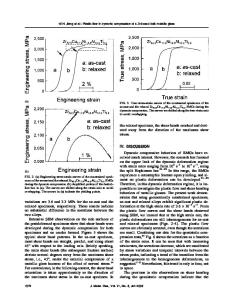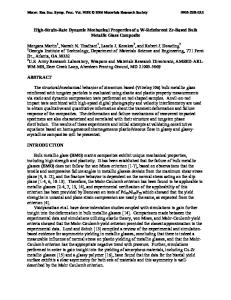Strain rate dependence of plastic flow in Ce-based bulk metallic glass during nanoindentation
- PDF / 189,866 Bytes
- 6 Pages / 585 x 783 pts Page_size
- 101 Downloads / 370 Views
Strain rate dependence of plastic flow in Ce-based bulk metallic glass during nanoindentation B.C. Weia) and L.C. Zhang National Microgravity Laboratory, Institute of Mechanics, Chinese Academy of Sciences, Beijing 100080, People’s Republic of China
T.H. Zhang and D.M. Xing State Key Laboratory of Nonlinear Mechanics (LNM), Institute of Mechanics, Chinese Academy of Sciences, Beijing 100080, People’s Republic of China
J. Das and J. Eckertb) FG Physikalische Metallkunde, FB 11 Material- und Geowissenschaften, Technische Universität Darmstadt, D-64287 Darmstadt, Germany; and Leibniz-Institut für Festkörperund Werkstoffforschung Dresden, Helmholtzstraße 20, D-01069 Dresden, Germany (Received 15 June 2006; accepted 18 September 2006)
The strain rate dependence of plastic deformation of Ce60Al15Cu10Ni15 bulk metallic glass was studied by nanoindentation. Even though the ratio of room temperature to the glass transition temperature was very high (0.72) for this alloy, the plastic deformation was dominated by shear banding under nanoindentation. The alloy exhibited a critical loading rate dependent serrated flow feature. That is, with increasing loading rate, the alloy exhibited a transition from less prominent serrated flow to pronounced serrated flow during continuous loading but from serrated to smoother flow during stepped loading. I. INTRODUCTION
The plastic deformation of bulk metallic glasses (BMGs) is classified as either homogeneous or inhomogeneous. 1,2 Homogeneous deformation in metallic glasses usually takes place at high temperatures (>0.70 Tg; Tg represents glass transition temperature). The deformation behavior of BMGs near Tg can be Newtonian or non-Newtonian, depending on temperature and imposed strain rate.3–8 Inhomogeneous deformation usually occurs at low temperatures or larger strain rates and is characterized by the formation of localized shear bands, followed by their rapid propagation and catastrophic fracture.1,2 In constrained loading modes (e.g., compression or indentation), global plastic deformation at room temperature is possible, where flow is typically found to be serrated.9–18
a)
Address all correspondence to this author. e-mail: [email protected] b) This author was an editor of this focus issue during the review and decision stage. For the JMR policy on review and publication of manuscripts authored by editors, please refer to http:// www.mrs.org/jmr_policy. DOI: 10.1557/JMR.2007.0039 258
J. Mater. Res., Vol. 22, No. 2, Feb 2007
Recently, nanoindentation has been increasingly used to evaluate the mechanical response of metallic glasses, due to its superiority for observation of deformation mechanisms under well-controlled conditions.10–19 It was shown that the characteristic features of serrated flow depend on the alloy composition and the structure of BMGs.10–18 Serrated flow strongly depends on the strain rate during indentation: lower rates promote more prominent serrations or displacement bursts.11–13,17,18 Schuh and Nieh suggested a transition in plastic flow where serrations
Data Loading...











